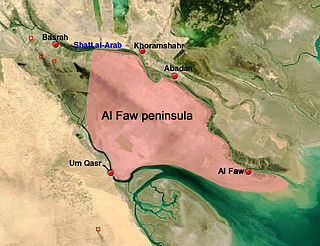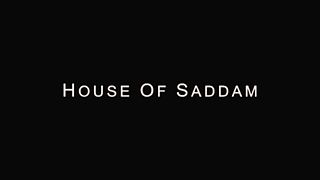The Saddam Line consisted of defensive fortifications constructed by Saddam Hussein's Iraqi Army on Kuwait's border with Saudi Arabia after Iraq had invaded and occupied Kuwait in August 1990.
The Western media presented fears that it would present a formidable obstacle to the liberation of Kuwait, consisting of "flame trenches" (ditches filled with oil to be ignited in case of attack) [1] [2] and "sand berms, trench works, anti-tank ditches, barbed wire and minefields", [3] backed by the threat of chemical and biological weapons. The objective of Hussein was to force the coalition to engage in costly trench warfare. [4] However, those fears turned out to be unwarranted. The Coalition assault, beginning at 4 a.m. on February 24, 1991, met "only sporadic resistance", and by 6:45 a.m., troops had broken through the Saddam Line. [5] The US forces charged the Iraqi lines with M1 Abrams tanks modified with minesweeping plows and M728 Combat Engineer Vehicles which buried the trenchlines, and in many cases, buried Iraqi troops alive, the number of which has been estimated to be "in the thousands". [4] Though the Iraqi Government said they found 44 bodies. So it is unknown the true number. Reference https://www.pbs.org/wgbh/pages/frontline/gulf/appendix/death.html

The Iran–Iraq War, also known as the First Gulf War, was an armed conflict between Iran and Iraq that lasted from September 1980 to August 1988. Active hostilities began with the Iraqi invasion of Iran and lasted for eight years, until the acceptance of United Nations Security Council Resolution 598 by both sides. Iraq's primary rationale for the attack against Iran cited the need to prevent Ruhollah Khomeini—who had spearheaded the Iranian Revolution in 1979—from exporting the new Iranian ideology to Iraq. There were also fears among the Iraqi leadership of Saddam Hussein that Iran, a theocratic state with a population predominantly composed of Shia Muslims, would exploit sectarian tensions in Iraq by rallying Iraq's Shia majority against the Baʽathist government, which was officially secular and dominated by Sunni Muslims. Iraq also wished to replace Iran as the power player in the Persian Gulf, which was not seen as an achievable objective prior to the Islamic Revolution because of Pahlavi Iran's economic and military superiority as well as its close relationships with the United States and Israel.

Saddam Hussein Abd al-Majid al-Tikriti was an Iraqi politician and revolutionary who served as the fifth president of Iraq from 1979 to 2003. He also served as prime minister of Iraq from 1979 to 1991 and later from 1994 to 2003. He was a leading member of the revolutionary Arab Socialist Ba'ath Party and later the Baghdad-based Ba'ath Party and its regional organization, the Iraqi Ba'ath Party, which espoused Ba'athism, a mix of Arab nationalism and Arab socialism. He was responsible for numerous human rights abuses including an estimated of 250,000 arbitrary deaths and disappearances. Saddam was convicted for crimes against humanity, specifically for the Dujail Massacre and was sentenced to death by hanging.

The Iraqi Republican Guard was a branch of the Iraqi military from 1969 to 2003, which existed primarily during the presidency of Saddam Hussein. It later became known as the Republican Guard Corps, and then the Republican Guard Forces Command (RGFC) with its expansion into two corps. The Republican Guard was disbanded in 2003 after the invasion of Iraq by a U.S.-led international coalition.

The Gulf War was an armed conflict between Iraq and a 42-country coalition led by the United States. The coalition's efforts against Iraq were carried out in two key phases: Operation Desert Shield, which marked the military buildup from August 1990 to January 1991; and Operation Desert Storm, which began with the aerial bombing campaign against Iraq on 17 January 1991 and came to a close with the American-led liberation of Kuwait on 28 February 1991.

This is a timeline of the events surrounding the United States-led invasion of Iraq in 2003.

The 2003 invasion of Iraq was the first stage of the Iraq War. The invasion began on 19 March 2003 and lasted just over one month, including 26 days of major combat operations, in which a United States-led combined force of troops from the United States, the United Kingdom, Australia and Poland invaded the Republic of Iraq. Twenty-two days after the first day of the invasion, the capital city of Baghdad was captured by coalition forces on 9 April after the six-day-long Battle of Baghdad. This early stage of the war formally ended on 1 May when U.S. President George W. Bush declared the "end of major combat operations" in his Mission Accomplished speech, after which the Coalition Provisional Authority (CPA) was established as the first of several successive transitional governments leading up to the first Iraqi parliamentary election in January 2005. U.S. military forces later remained in Iraq until the withdrawal in 2011.

The Iraqi no-fly zones conflict was a low-level conflict in the two no-fly zones (NFZs) in Iraq that were proclaimed by the United States, United Kingdom, and France after the Gulf War of 1991. The United States stated that the NFZs were intended to protect the ethnic Kurdish minority in northern Iraq and Shiite Muslims in the south. Iraqi aircraft were forbidden from flying inside the zones. The policy was enforced by the United States and the United Kingdom until 2003, when it was rendered obsolete by the 2003 invasion of Iraq. French aircraft patrols also participated until France withdrew in 1996.

Live from Baghdad is a 2002 American television war drama film directed by Mick Jackson and co-written by Robert Wiener, based on Wiener's book of the same title. The film premiered on HBO on December 7, 2002, during the prelude stage of the Iraq War.
This is a list of aviation-related events from 1991.

The Battle of Khafji was the first major ground engagement of the Gulf War. It took place in and around the Saudi Arabian city of Khafji, from 29 January to 1 February 1991.

The Iraqi invasion of Kuwait began on 2 August 1990 and marked the beginning of the Gulf War. After defeating the State of Kuwait on 4 August 1990, Iraq went on to militarily occupy the country for the next seven months. The invasion was condemned internationally, and the United Nations Security Council (UNSC) adopted numerous resolutions urging Iraq to withdraw from Kuwaiti territory. The Iraqi military, however, continued to occupy Kuwait and defied all orders by the UNSC. After initially establishing the "Republic of Kuwait" as a puppet state, Iraq annexed the entire country on 28 August 1990; northern Kuwait became the Saddamiyat al-Mitla' District and was merged into the existing Basra Governorate, while southern Kuwait was carved out as the all-new Kuwait Governorate. By November 1990, the adoption of UNSC Resolution 678 officially issued Iraq an ultimatum to withdraw unconditionally by 15 January 1991 or else be removed by "all necessary means" from Kuwaiti territory. In anticipation of a war with Iraq, the UNSC authorized the assembly of an American-led military coalition.
The aftermath of Gulf War saw drastic and profoundly significant political, cultural, and social change across the Middle East and even in areas outside those that were directly involved.

The Iraqi Armed Forces are the military forces of the Republic of Iraq. They consist of the Iraqi Army, the Iraqi Air Force, and the Iraqi Navy. Along with these three primary service branches, there exists the Iraqi Counter Terrorism Service and the Popular Mobilization Forces. The President of Iraq acts as the supreme commander as outlined by the constitution.

The 1991 Iraqi uprisings were ethnic and religious uprisings against Saddam Hussein's regime in Iraq that were led by Shi'ites and Kurds. The uprisings lasted from March to April 1991 after a ceasefire following the end of the Gulf War. The mostly uncoordinated insurgency was fueled by the perception that Iraqi President Saddam Hussein had become vulnerable to regime change. This perception of weakness was largely the result of the outcome of the Iran–Iraq War and the Gulf War, both of which occurred within a single decade and devastated the population and economy of Iraq.

The First Battle of al-Faw was a battle of the Iran–Iraq War, fought on the al-Faw peninsula between 10 February and 10 March 1986. The Iranian operation is considered to be one of Iran's greatest achievements in the Iran–Iraq War. The Iranians were able to capture the al-Faw peninsula, cutting off Iraqi access to the Persian Gulf in the process; this in turn hardened Iraqi attitudes to prosecute the war. The Faw peninsula was later recaptured by Iraqi forces near the end of the war.
The Battle of Karbala was fought during the 1991 uprisings in Iraq which followed the Gulf War. The battle started after demoralized troops throughout Iraq began to rebel against Saddam Hussein. From 5 to 19 March 1991, the city of Karbala became a chaotic battlefield as the result of bitter fighting between the insurgents and the Iraqi Republican Guard. After the failure of the uprising, citizens were killed in large numbers. Parts of the city were nearly leveled.

Iraq–Saudi relations are the bilateral and diplomatic relations between the Republic of Iraq and the Kingdom of Saudi Arabia. Both sovereign states share the Iraq–Saudi Arabia border.

House of Saddam is a 2008 British docudrama television miniseries that charted the rise and fall of Saddam Hussein. A co-production between BBC Television and HBO Films, the series was first broadcast on BBC Two in four parts between 30 July and 20 August 2008.

The Liberation of Kuwait campaign was led by the United States between 24 and 28 February 1991, consisting of a major ground offensive into Iraqi-occupied Kuwait following the successful Gulf War air campaign. Approximately 650,000 troops of the American-led 42-country coalition swept into Kuwait to find the bulk of the 500,000 Iraqi troops surrendering en masse, but there were still pockets of resistance in some parts of the country. A particularly fierce battle took place at Kuwait International Airport, where Iraqi troops, seemingly unaware that a retreat order had been issued to them, continued to fight against the coalition's advance. By the end of February, Kuwait was declared free of the Iraqi occupation. The coalition then proceeded to push into Iraq, where the majority of the fighting occurred. Shortly thereafter, combat operations ceased and the Gulf War was brought to a close.
The timeline of the Gulf War details the dates of the major events of the 1990–1991 war. It began with the Iraqi invasion of Kuwait on 2 August 1990 and ended with the Liberation of Kuwait by Coalition forces. Iraq subsequently agreed to the United Nations' demands on 28 February 1991. The ground war officially concluded with the signing of the armistice on 11 April 1991. However, the official end to Operation Desert Storm did not occur until sometime between 1996 - 1998. Major events in the aftermath include anti-Saddam Hussein uprisings in Iraq, massacres against the Kurds by the regime, Iraq formally recognizing the sovereignty of Kuwait in 1994, and eventually ending its cooperation with the United Nations Special Commission in 1998.